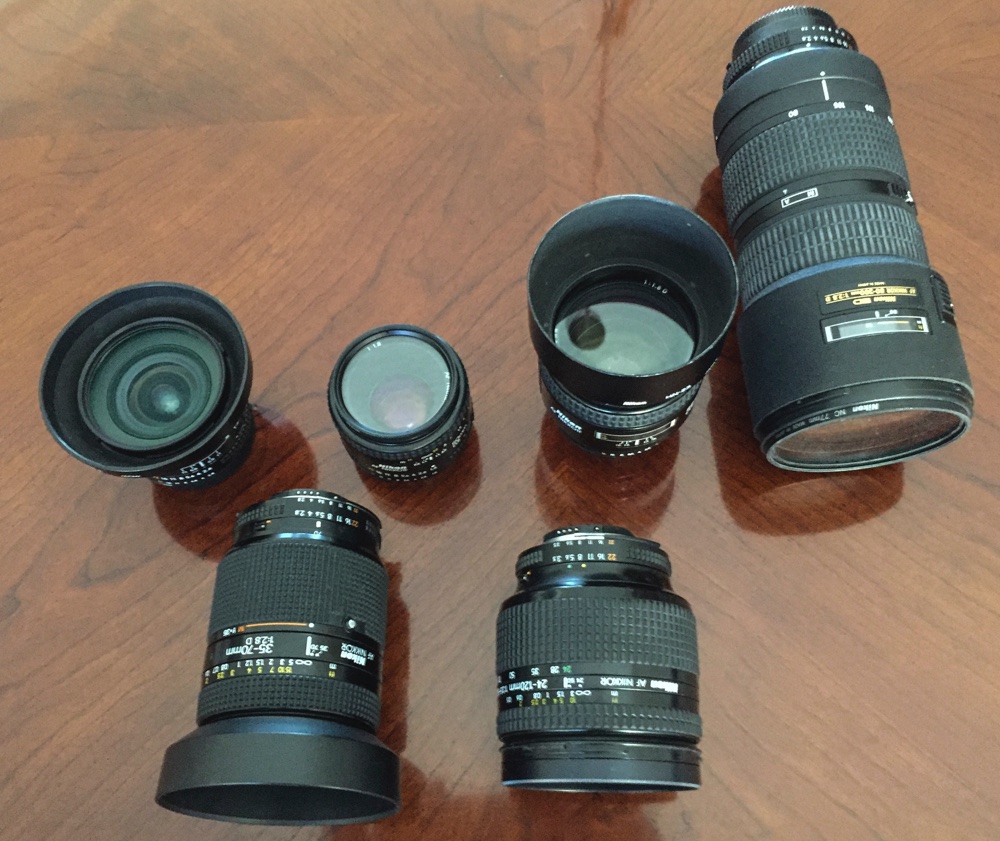A curious bunch.
Before Nikon migrated to AF lenses with built in linear focus motors – the AFS series – they marketed the AF and AFD ranges which used a screwdriver linkage in the lens for focusing, the actual focus motor being in the body of better film and digital Nikon SLRs.

The Nikon screw drive motor coupling on the body and in the lens mount.
The film era F100 works well with these and just as well with the latest AFS optics.
While a seemingly Rube Goldberg solution it has proved to be solid and reliable with millions of lenses made. The line started around 1986 and one or two are made to this day.
What is odd about the AF and AFD lenses (the later AFD versions added an enhanced metering chip for better results with flash; otherwise all else was identical) is just how much construction quality varied across the line. I have a half-dozen:

My small AF/AFD collection – 20/2.8, 50/1.8, 85/1.8 and 80-200/2.8 ED IF rear row;
35-70/2.8 and 24-120 f/3.5-5.6 front row.
The mechanical stand-outs here are the 80-200 and 35-70. The former is a two ring zoom, the latter a push-pull design which wears less well, the action becoming sloppy with age. Both are fabulously made and optically as good as it gets. The 80-200 is still sold new at over $1,000, my mint sample running me just $476. The limited range 35-70 is long discontinued (1987-2005) and is often found for under $200. Both are wonderful bargains.
The mechanical quality story with the others is quite a bit different. All these optics have proper aperture rings, a feature sadly deleted from the latest AFS line where apertures are set using one of the command dials on the body of the camera. The 50/1.8 is a piece of garbage. Cheap materials, rattling internals, awful controls. And dirt cheap at $70 used, mint. The 20mm ($230) and 85mm ($270) are mechanically so-so, but focus fast with the 85mm especially pleasant to use in the portrait studio where acquiring focus on the subject’s eyes is a piece of cake with AF especially fast.
And the 24-120mm is a jack-of-all-trades and master of none. It comes with fairly pronounced barrel distortion, rather wobbly construction, an unspectacular f/5.6 at the long end yet it’s invariably found on my D700 or F100 when I want to lug only one optic along. The 24mm comes in especially handy for architectural images and the barrel distortion is easily removed in LR. At well under $100 for a mint one, it’s hard to pass by.
Where Nikon did not compromise is in the optical quality of these lenses. All are at least as good as their MF predecessors with the 80-200 considerably better (and bulkier) than what came before. It’s a weapon, not a lens. The 85mm, with its chintzy external plastic, can almost match the classic 85/1.8 MF at full aperture, equalling it at f/4 and below. And even that piece of garbage, the 50/1.8 is almost as good as the classic 50/2 MF – it’s 1.5 stops less sharp at f/2 compared to the old MF optic, but usable wide open even in the extreme corners. Finally the 20/2.8, which scarcely needs AF owing to large depth of field, is almost as good as the classic 20/3.5 UD MF …. made 21 years earlier.
If MF is not for you, or you are just feeling lazy, none of these economically priced AF/AFD Nikkors will let you down. Just make sure your body comes with the screwdriver coupling or AF will be lost. Sadly, none of these will AF on the new FF Z6/Z7 mirrorless bodies, which lack the screwdrive motor in either the body or the related adapter.
For an index of my Nikkor pieces click here.